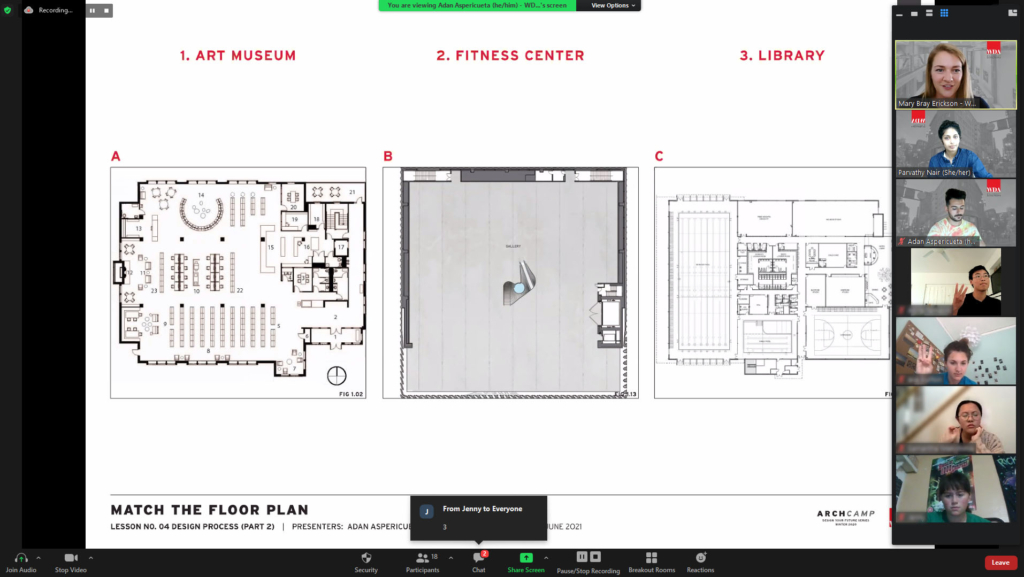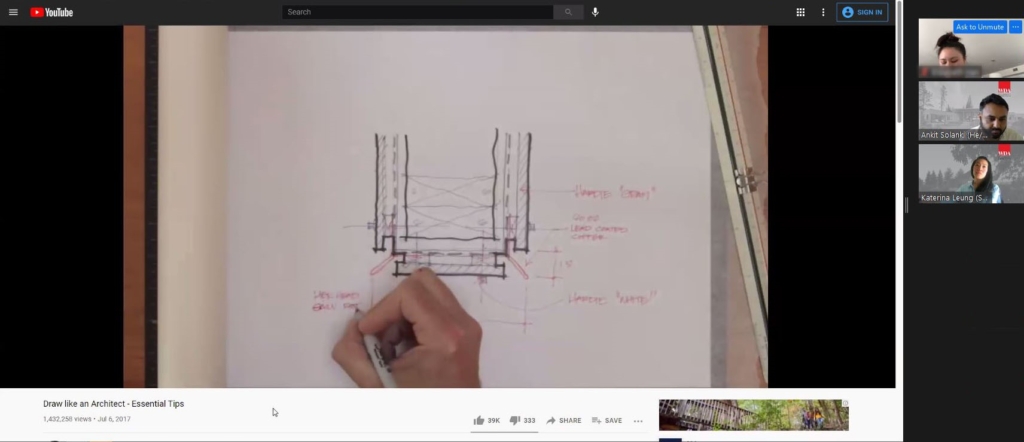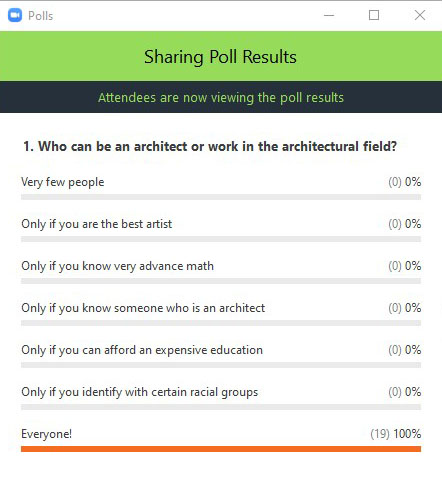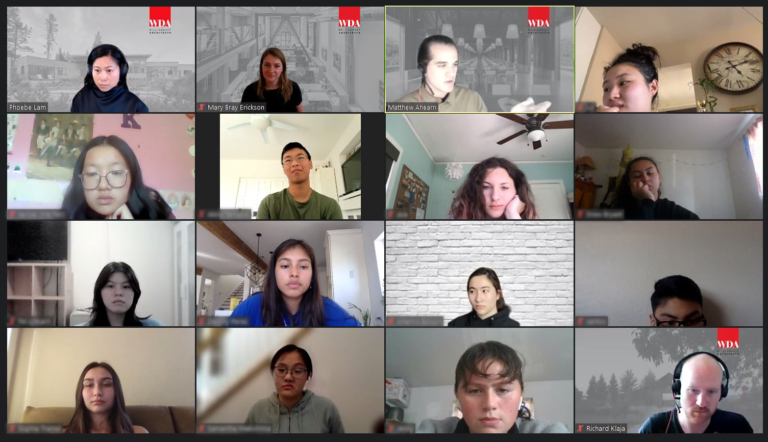School was back in session this summer for our second year of Arch Camp. Produced and designed by our DEI+I (Diversity Equity Inclusion + Impact) group, Arch Camp is a crash course in architecture for local high school students. We caught up with two of the Camp leaders, Mary Bray Erickson and Parvathy Nair, for impact highlights from this year, tips on how to engage students after a long day on Zoom and much more.
WDA: Why did we create Arch Camp?
Parvathy Nair (PN): One of our DEI+I goals is local action – for us that means investing in the community for equity in the built environment and diversity in the architecture profession. Arch Camp is an initiative that moves us towards this goal.
Mary Bray Erickson (MBE): Arch Camp was born out of internal firm-wide conversations about racial equity in the wake of the Black Lives Matter Movement. We began reflecting on ways that we can do our part to support the movement. Historically, the architecture profession isn’t known for its diversity. We wanted to focus our efforts on making a change in the best way we could with our available resources. Expanding the profession to include underrepresented members of society starts with exposing young people to the profession, showing them what it is like to work as an architect, and opening students’ eyes to the possibility of architecture as a career path.

WDA: How did you find the students?
MB: Last year was more of a grassroots effort and less structured. Friends who coach, mentor, and tutor local youth introduced us to students who had previously expressed interest in pursuing architecture as a career.
For this year’s Arch Camp, in addition to connections through our own networks, we put more structure and specificity on student recruitment and linked up with schools or organizations where this program can make the most impact. This allowed us to fine-tune our intention and realign with our original DEI+I goals and Arch Camp objective.
PN: We started our search for students by looking at data on demographics and income levels of local schools and neighborhoods. Then we reached out to school program managers and teachers for direction. We also shared a flyer with the schools for email distribution along with an online application process. I especially want to give a shoutout to Tatiana Newman-Wade and Emiliano Sanchez from Oakland Unified School District, who helped support the outreach process and provided great tips on how to teach students virtually during this pandemic.
WDA: How does diversity improve architecture?
MBE: Diversity is what makes design great. If you have a bunch of people from the same area, who are the same age, who come from the same background and who have had similar life experiences, they are going to design something for people just like them. When you have a diverse group, they can reduce blind spots and create a more well-rounded and inclusive design that is better for all.
PN: Design is better with different perspectives.
This is a small program, but it’s one step in dismantling inequities in our industry. When I was interviewing for a new job after college, many management teams included only white men. It was cool to see people of color and women in management positions here at WDA. That meant there was space for me, and it was a huge reason I joined the firm.

WDA: What were some of the interactive learning tools you used?
PN: The most effective elements we had were the Zoom breakout rooms where we would sketch together on digital white boards. It was the closest thing to drawing that we could achieve in this virtual platform without requiring the students to have anything on hand. Creating access and engagement opportunities for students without having any tools was important to us.
By breaking up the class into smaller groups of 4 or 5, the students felt more comfortable speaking up and sharing their thoughts. Over the course of six lessons, we slowly started to build comfort and trust in each other. It’s not just about having fun lessons; it’s about fostering inclusion within the lesson itself.
MBE: In reflecting on lessons learned from last year’s program, we decided we wanted to lecture less and encourage more participation among students. We revamped the lessons from last year and eliminated 30% of the content to allow for more time for interactive elements. We also used this great website, Mentimeter – a rapid online polling platform. We customized it for each lesson and the students really enjoyed engaging with it.
WDA: What kind of impact does this program make?
PN: Based on the students’ feedback surveys, I think the real impact is that students were excited about architecture, and they saw how they could fit into the field. Something I learned later in my career is there are so many different niches within the profession. By introducing the students to a diverse set of people in the field, in terms of identities and interests, we hope that we showed them a potential future in architecture for themselves.
We also offered to be a resource for the students, to help them make connections and to continue to mentor them beyond Arch Camp’s duration if they are interested. In that sense, we’re having a longer-term impact because it’s not just for the duration of the program and they have us as a resource; we are available to them even after Arch Camp is over.
MBE: Reading the student feedback is very validating – it is clear they enjoyed their time spent with us, they have a better grasp on whether architecture is the right career path for them, and they had fun learning about our profession. After each lesson, we always asked for feedback on what they’d suggest we change. After our final lesson, the only constructive comments we received was that they wished the lessons were longer and they’d had more time with us.
PN: I think about the people who were in my community while growing up in the Bay Area. They empowered me and constantly told me that I could succeed. They gave me access to a great future, not just through opportunities but through validation and sharing their passion. Arch Camp is a way for us to extend that to the students in our community.

WDA: How did it impact you?
PN: It’s really humbling to work with students who are asking why you do what you do. It was refreshing for me, and it was eye opening for them. We learned a lot from the students as well.
MBE: It’s reinvigorating. When you share why you love what you do with others, it serves as a reminder for yourself, too. To be able to share my passion with someone else and potentially have an impact on their life path is such a gift. After being on the weekly Arch Camp calls with the students, I was always beaming ear to ear.
WDA: What are your plans for the future of Arch Camp?
MBE: At this point, we are planning to continue the program every year. We will take into account all of the student feedback we received and keep improving the lessons.
PN: We want to make it even better. It was a real challenge with COVID to keep things interactive, interesting and engaging, especially when students are already so exhausted from being on Zoom all day for school. In the future we want to have site visits and create more inter-personal connections between people at our firm and students that go to school in our community.
Written by Wendy Osaki
Article Contributors
Brenna Daugherty; Mary Bray Erickson, Architect; Phoebe Lam, Architect; Sarah Mergy; Parvathy Nair, Architect
WDA Arch Camp Presenters & Moderators
Matthew Ahearn; Adan Aspericueta; Karen Chang, Architect; Alex Croft; Glorimar Irizarry Delgado; Mary Bray Erickson, Architect; Allison Foronda; Richard Klaja, Architect; Phoebe Lam, Architect; Katerina Leung; Parvathy Nair, Architect; Dillon Parker, Architect; Ankit Solanki
Special Thanks
Tatiana Newman-Wade / Work-Based Learning Program Liason / OUSD
Emiliano Sanchez / Director of CTE Trades and Apprenticeships / OUSD
Lillian Hsu / Principal / Latitude High School
Chris Nye / College & Career Counselor / Encinal Jr. Sr. High School
Lee Kaplan / College & Career Counselor / Encinal Jr. Sr. High School
